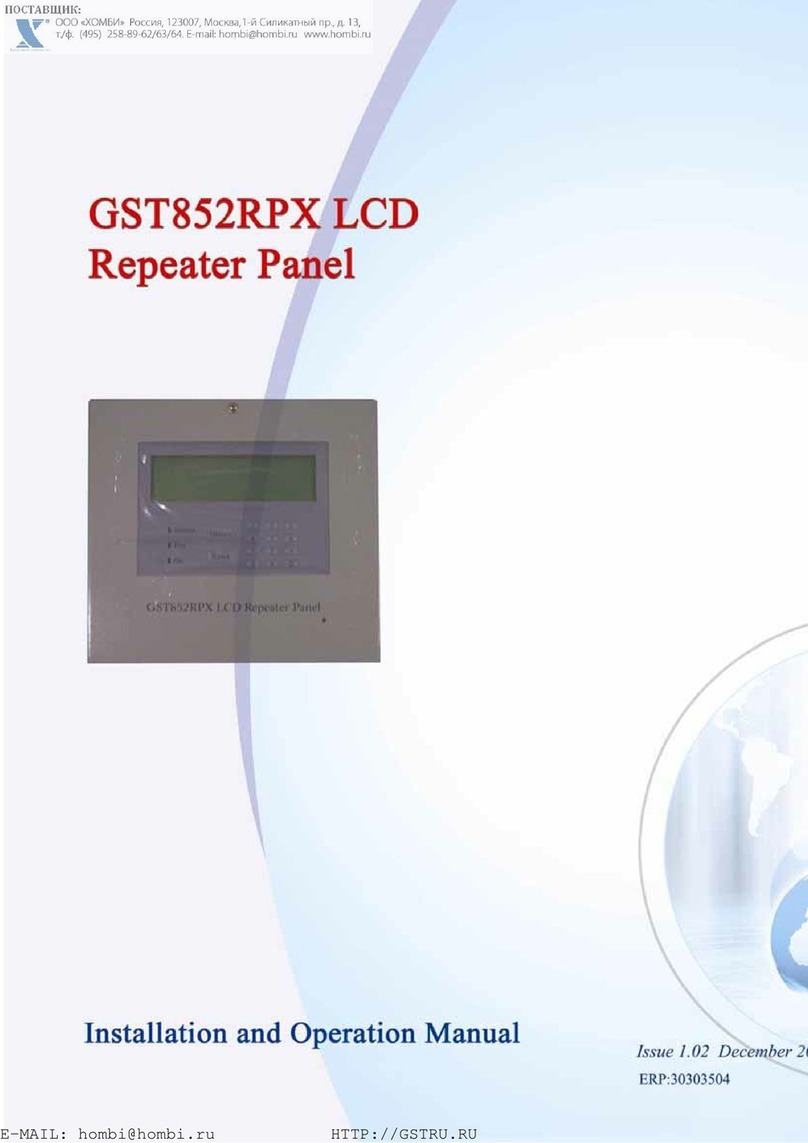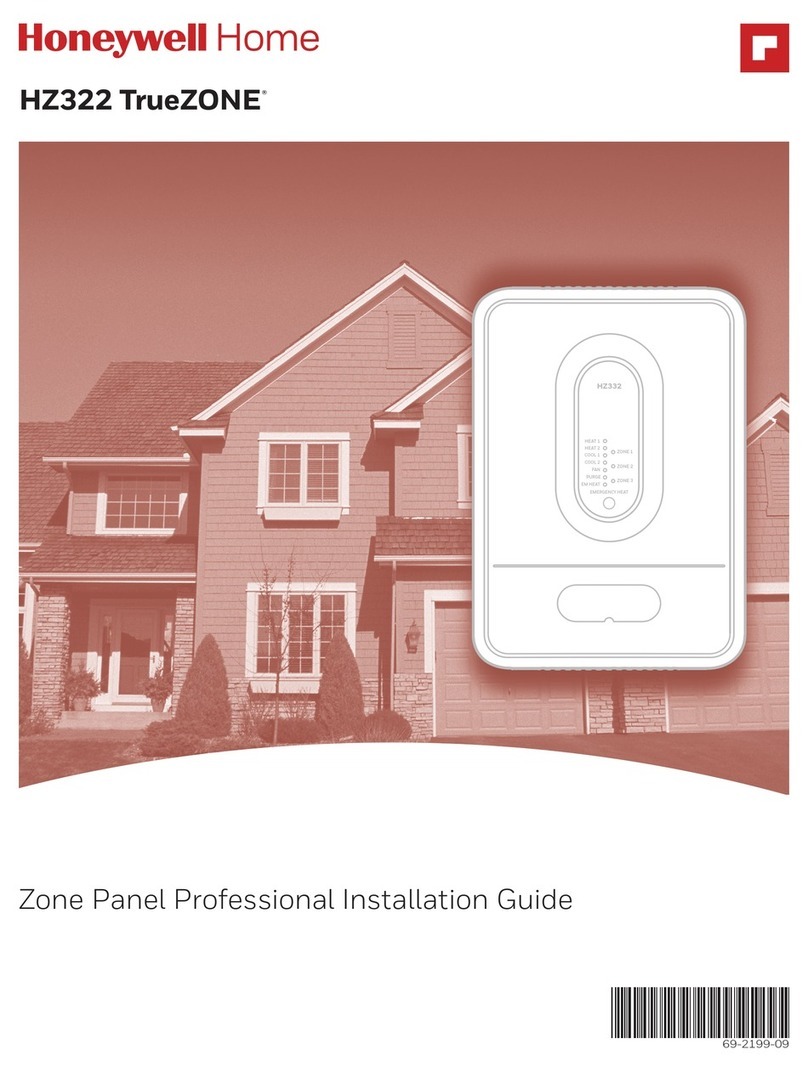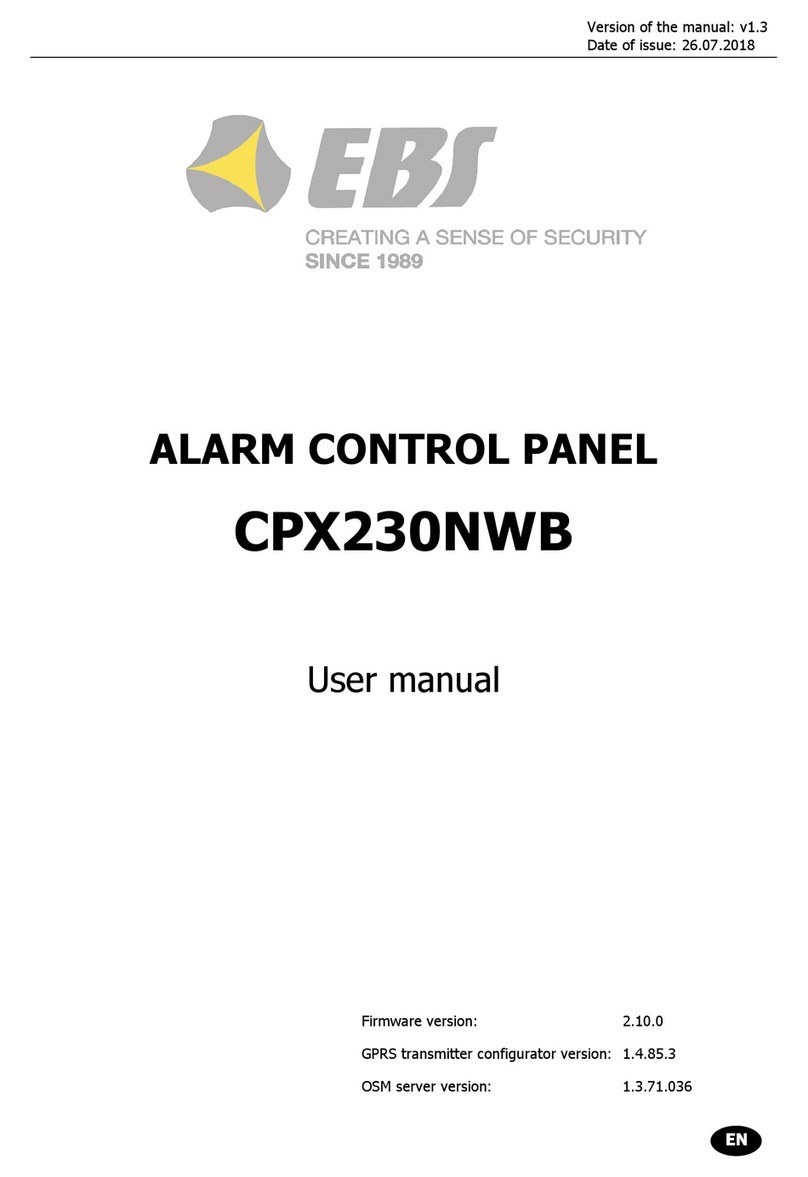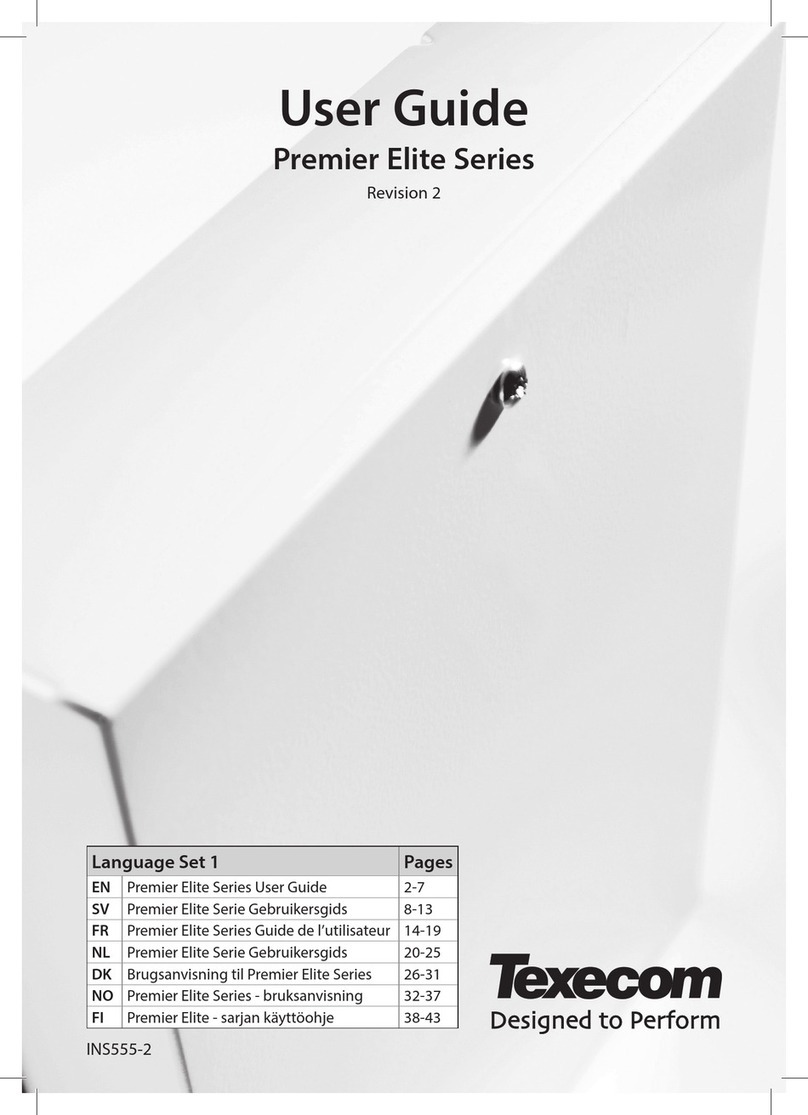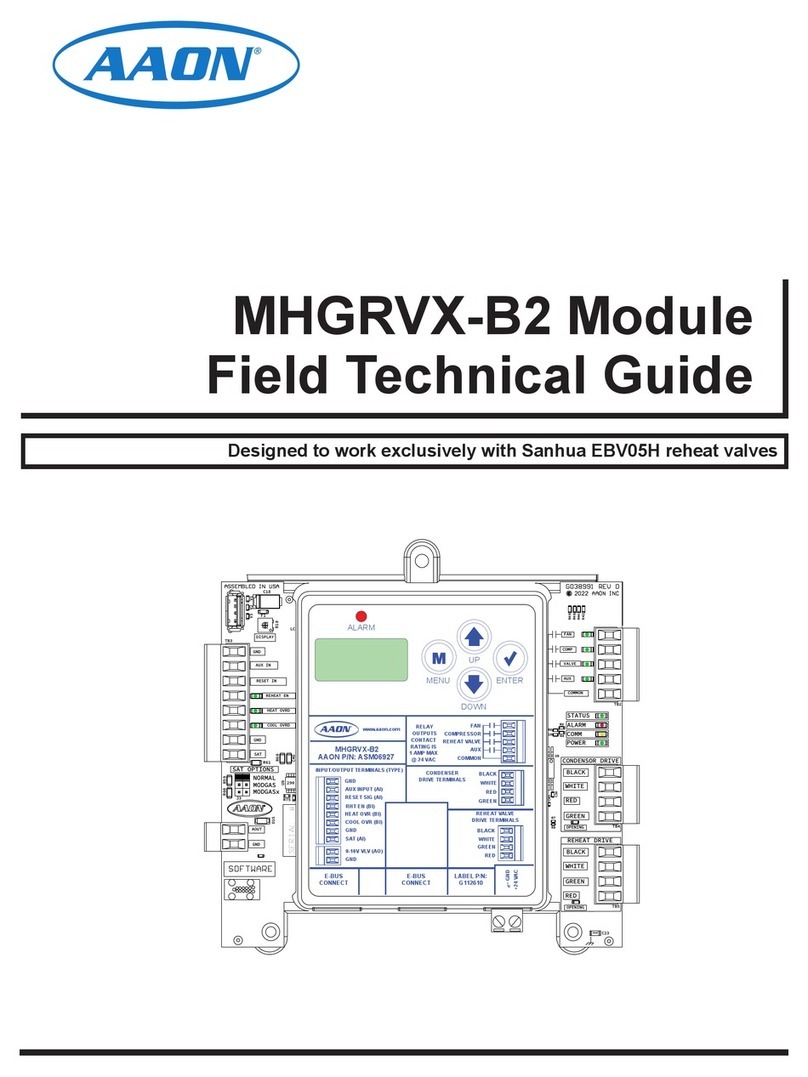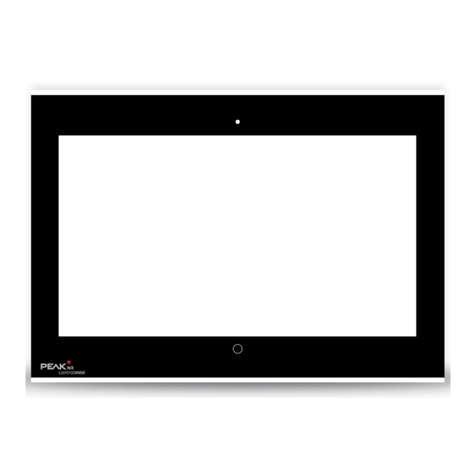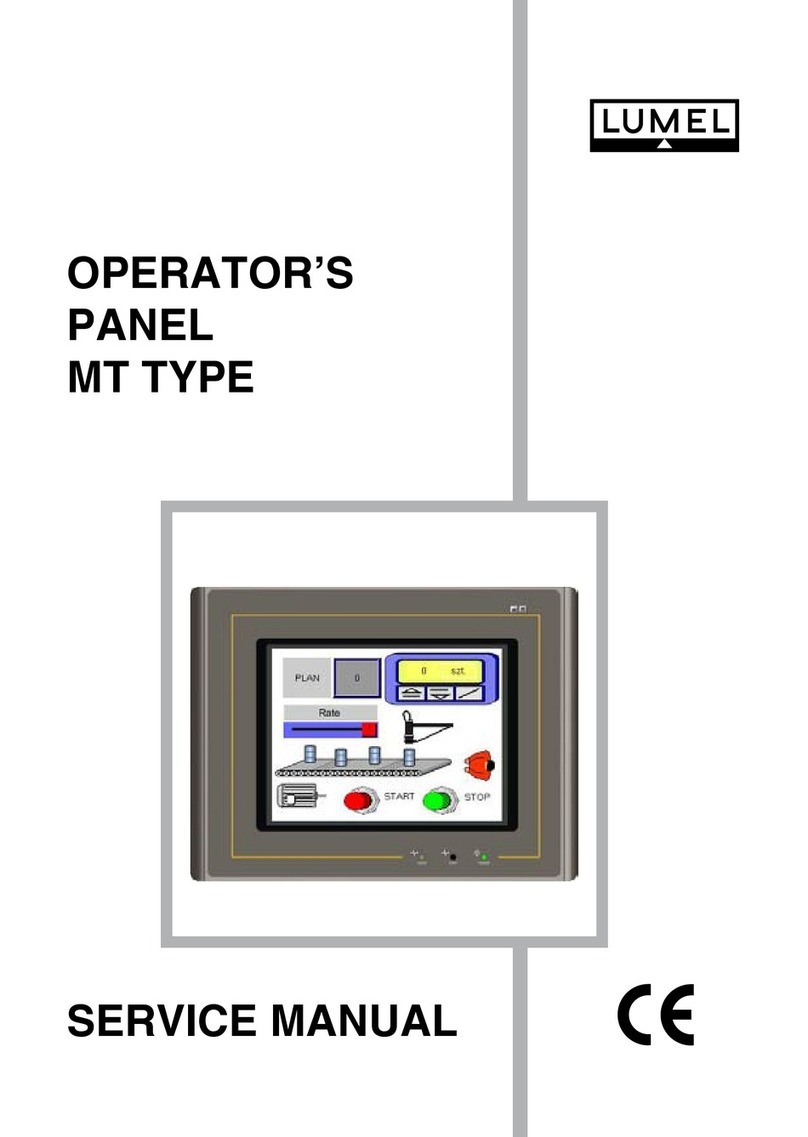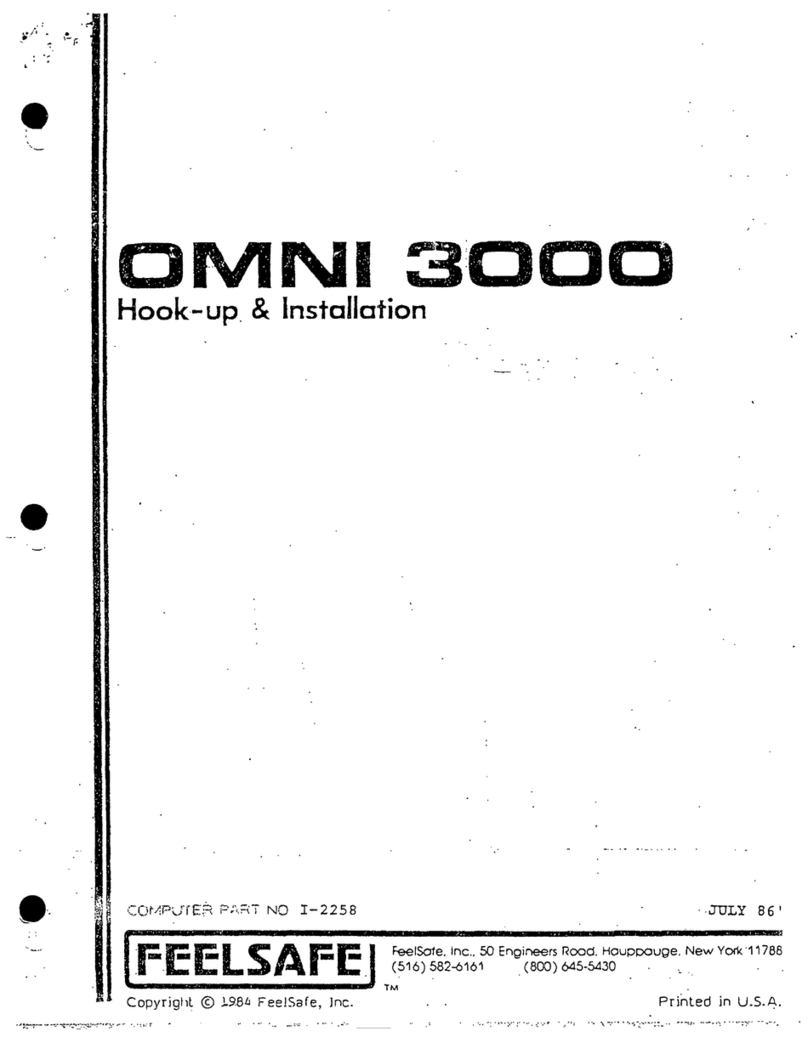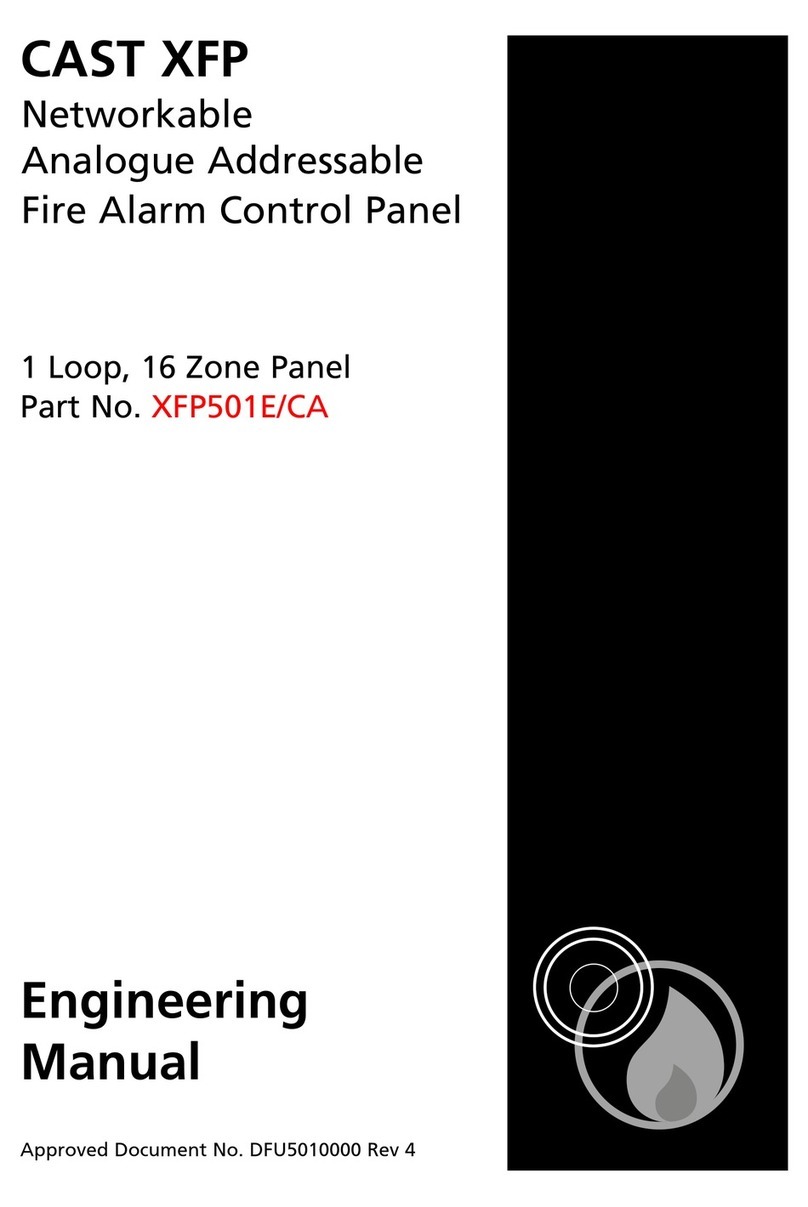Fire Pro FP-08450 User manual

Fire Detection and
Activation System
Model 08450
Rev 2.7

Page | 2
Contents
1 Introduction ............................................................................................ 3
1.1 General Information ....................................................................... 3
1.2 How Does it Work .......................................................................... 3
1.3 In Case of Fire ............................................................................... 3
2 Components List...................................................................................... 4
3 Design Considerations.............................................................................. 5
3.1 Main Power Supply Input ................................................................ 5
3.2 Backup Power Supply Input ............................................................ 5
3.3 Siren/Strobe Output ....................................................................... 5
3.4 Discharge Output ........................................................................... 5
3.5 Detection Circuit 1 Alarm Output ..................................................... 6
3.6 Detection Circuit 2 Alarm Output ..................................................... 6
3.7 Mounting ....................................................................................... 6
3.8 Cabling Requirements..................................................................... 7
3.9 Connecting Multiple FirePro Generators ........................................... 7
4 Installation .............................................................................................. 8
5 Wiring Diagram ......................................................................................12
6 Programming..........................................................................................13
7 Operation...............................................................................................13
7.1 LED Indicators ..............................................................................13
7.2 Isolate Function ............................................................................13
7.3 Reset Function ..............................................................................14
7.4 Test Function ................................................................................14
7.5 Discharging the Fire System...........................................................14
7.6 Alarm Silence ................................................................................14
8 Commissioning .......................................................................................15
9 Servicing and Maintenance ......................................................................16
9.1 Daily Service Schedule...................................................................16
9.2 Semi-annual / Annual Service Schedule ..........................................16
10 Troubleshooting......................................................................................17
10.1 Internal Faults...............................................................................17
10.2 External Faults ..............................................................................17
11 Specifications .........................................................................................18
12 RFI Environments ...................................................................................19
13 Safety Data Sheet (SDS) - FirePro............................................................19
14 Marine Installation Notes (AMSA NSCV)....................................................20

Page | 3
1Introduction
1.1 General Information
The FirePro FP-08450 Fire Control Panel is a combined detection and extinguishant system,
and is compliant for use in marine (AMSA NSCV).
The FIP (fire indicator panel) incorporates:
-2x Detection circuits;
-1x Extinguishing Discharge circuit;
-1x Siren/Strobe circuit;
-Programmable Activation (automatic and/or manual);
-Fault Monitoring system;
-Isolation Function.
1.2 How Does it Work
All FirePro Aerosol Generators use the latest generation FPC solid compound. Upon activation,
the solid compound is transformed into a rapidly expanding, highly efficient gas, based on
Potassium salts. It does not deplete oxygen levels. The built-in fail-safe activation system
ensures operation of the generators when required, even if everything else fails. At 300⁰C the
FPC block changes to a potassium-based gas to extinguish the fire.
Ozone Depletion Potential (O.D.P.) = 0
Atmospheric Life Time (A.L.T.) = 0
Global Warming Potential (G.W.P.) = 0
Non-corrosive & Non-toxic
1.3 In Case of Fire
If a fire occurs, equipment operators should do the following:
1. Detection will initiate an alarm condition on the FirePro System
2. The siren/strobe will operate and if shutdown relays have been installed, equipment
shutdown will be initiated.
3. Evacuate all personnel from the risk area.
4. Close all hatches and openings, and shutdown engines and any extraction fans or vents.
5. Manual Activation: Press and hold both mode switches continuously for 5 seconds to
activate the system.
6. Remote Activation Switches: The control panel will automatically begin the activation
sequence when remote activation switches (where installed) are pushed (Det Circuit 1).
7. Keep the FirePro suppression gas within the risk until the fire is extinguished and not able
to re-ignite.
8. Do not start engine or fans until the fire is extinguished. Operating the exhaust fans will
enable the gas to escape the risk area and could allow the fire to re-ignite.
9. Do not enter the risk until it has been rendered safe.
10.Recommended clean up after discharge is with soapy water and a cleaning agent based on
citric acid.
11.Following a discharge, replace all installed FirePro Generators.

Page | 4
2Components List
FP-08450
Fire Control Panel
Detection and extinguishant
control system
4x DP-3000
1x DP-2000
2x FP-08950
1x
1x
1x
1x
Deutsch Plug 3 Pin F, c/w heatshrink
Deutsch Plug 3 Pin M, c/w heatshrink
End-of-line Plug 4k7Ω(Detection)
End-of-line Diode 1N4004 (Siren/Strobe)
Charging Diode 1N5404 (Backup Power)
End-of-Line Resistor 3k3Ω (Discharge)
Operator’s Manual
Agent Release Circuit
Siren / Strobe Circuit
FP-08918
Wiring loom and Splitter Cable for
installaion of multiple FirePro
generators.
FP-08940
Siren/Strobe
Discharge Circuit
FirePro Aerosol
Generator
100g –500g Unit.
Constructed from Stainless Steel.
Comes with installed Deutsch Plug
for easy install
FP-6200
Heavy Duty Bracket 316 SS.
Suits FP-100, 200, 500 FirePro
Aerosol Generators.
FirePro Aerosol
Generator
1200g –5700g Unit.
Constructed from Stainless Steel.
Comes with installed Deutsch Plug
for easy install.
FP-6100
Heavy Duty Bracket 316 SS.
Suits FP-1200, 2000, 3000 5700
FirePro Aerosol Generators.
Detection Circuit (Circuit 1 Alarm & Circuit 2 Alarm)
FP-08920
Marine Grade Thermal Detector
60°C Fixed. Other temperatures
available on request.
FP-14053
Manual Call Point
Internal OR External
FP-09510
Linear Heat Detection Cable 182° C
FP-09511
Linear Heat Detection Installation kit.
Mounting Clips, 2x Junction Boxes
with strain relief cable glands and 1x
EOL for monitoring.
Installation Components
Service Components
FP-09500
2 Hour Fire Rated Shielded Cable.
FP-08960
Signage for the System. A sheet of
different size labels.
FP-08870/8871/8872
Power Control Module
Provides back up power for control
panel.
FP-08800
FirePro Simulator –for Testing &
Commissioning.
Additional Modules
FP-08850
Discharge Delay Module
Allows additional FirePro generators
to be discharged
FP-08860
Shutdown Relay Module
Provides facility for equipment
shutdown

Page | 5
3Design Considerations
3.1 Main Power Supply Input
The FP-08450 Fire Control Panel provide a single power supply input that is compatible with
12 / 24vDC. If adequate power is not supplied, the LEDs will not be illuminated, and the
control panel will not operate. The main power supply should be connected directly to a battery
or power source, not through a distribution board. The main power must not be interrupted if
the vessel is powered down. The FirePro Battery Lead (P/N FP-14016) may be used to connect
power to the control panel.
The recommended configuration is to use the vessel’s emergency batteries, provided that the
vessel has an automatic changeover for its power supply.
3.2 Backup Power Supply Input
A secondary power supply is required for marine installations. Where the vessel’s emergency
batteries are not suitable, the control panel will need to be connected to a secondary power
supply or the FP-08870/08871 Power Control Module will be required. The secondary power
supply should be connected directly to a battery or power source, not through a distribution
board. The secondary power supply must not be interrupted if the vessel or main power supply
is powered down. Note: The secondary power supply must be the same voltage as the main
power source.
3.3 Siren/Strobe Output
A siren is required for all marine installations. The recommended siren/strobe is the Flashni
Xenon Sounder Beacon. In a typical install, the maximum number of supported sirens/strobes
that can be installed is 5. When installed, Siren/Strobes are to be clearly visible and audible
at all points around the risk area.
The siren/strobe output is a monitored circuit. The supplied end-of-line diode (1N4004) must
be installed on the last siren/strobe in the circuit, otherwise the fire control panel will display
a fault.
3.4 Discharge Output
The maximum number of FirePro generators able to be discharged by the FP-08450 Fire
Control Panel is limited by the voltage of the main power supply. That is:
Voltage 12vDC Max = 2 Units
Voltage 24vDC Max = 4 Units
If a risk area requires a greater number of FirePro generators to be discharged than the
standard panel can provide, the FP-08850 Discharge Delay module can be used. The module
will discharge generators in multiples up to the maximum as above.
If the number of FirePro generators connected to each output is greater than the
maximum, the fire system will not operate.
When multiple FirePro generators are connected to a single output, they must be connected
using the FP-08919 Splitter Lead (see 3.9 Connecting Multiple FirePro Generators).
If a suppression system is not used, the supplied end-of-line resistor (3k3Ω) must be connected
to the Discharge output using the supplied deutsch plugs.

Page | 6
3.5 Detection Circuit 1 Alarm Output
The Circuit 1 Alarm Output is a zoned detection circuit capable of operating up to 30
conventional detectors, 100 metres of linear heat detection cable or 30 manual call points.
The Circuit 1 Alarm Output can be programmed for detection and alarm, or for automatic
discharge if an alarm is detected on this circuit (see 6. Programming).
Where remote actuation is needed, the FP-14053 Manual Call Point may be installed, and
Circuit 1 Alarm programmed for automatic discharge. Note: If remote activation is used, no
other detection devices should be installed on Circuit 1 Alarm.
The supplied end-of-line resistor (4k7Ω) must be installed on the last detector or manual call
point in the circuit, otherwise the fire control panel will display a fault. If detection is not used,
the supplied end-of-line plugs (marked green) must be connected to the Circuit 1 Alarm output.
3.6 Detection Circuit 2 Alarm Output
The Circuit 2 Alarm Output is a zoned detection circuit capable of operating up to 30
conventional detectors, 100 metres of linear heat detection cable or 30 manual call points.
The Circuit 2 Alarm Output is a detection and alarm circuit only. When in alarm condition the
siren/strobe will operate, however the suppression system will not discharge until manually
operated.
The supplied end-of-line resistor (4k7Ω) must be installed on the last detector or manual call
point in the circuit, otherwise the fire control panel will display a fault. If detection is not used,
the supplied end-of-line plugs (marked green) must be connected to the Circuit 2 Alarm output.
3.7 Mounting
For correct installation, the Fire Control Panel must be mounted by bolts or screws through the
mounting holes in the flange on both sides of the Module. No penetrations are to be made
through the casing of the panel. The Fire Control Panel enclosure is rated IP54, so should
be installed in a convenient location, away from where it may be affected by water.
It is necessary to complete all wiring and any programming of the detection mode prior to
mounting the panel.

Page | 7
3.8 Cabling Requirements
When constructing extension leads the supplied Deutsch Plugs must be used to ensure water-
proof connections are made throughout the installation.
1. Cut cable to required length and strip outer insulation to approximately 25-30mm.
2. Strip inner insulation to approximately 6mm and using a Deutsch Crimping tool, fix pins to
the exposed ends of the cable, including the earth where applicable.
3. Place heat shrink over the end of the cable.
Identify correct socket on plug by the
numbers/letter on the side of the plug and
push through the gasket at the bottom of the
plug until a click is heard and the pin is locked
in place.
4. Place the locking mechanism inside the plug to ensure pins remain secure. (Male plugs;
locking mechanism is orange. Female plugs; locking mechanism is green).
5. Using the heat shrink, seal the back of the
plug.
Cables are colour coded for easy identification.
When installing system, cables should be only
connected to the correctly coded cable. Colour
Coding for cables is as follows:
3.9 Connecting Multiple FirePro Generators
If multiple FirePro Generators are being installed on a single output, they must be connected
using the FP-08918 Splitter Lead. The Splitter Lead enables the activation current to pass
uninterrupted to all connected FirePro generators and allows for continuous monitoring.
Splitter Leads can be installed at any point on the activation circuit and do not need to be
installed adjacent to the fire control panel or the discharge delay module. For ease of install,
servicing and more efficient field wiring, Splitter Leads should be installed in areas easy to
access and should be used to minimise the required extension leads, and to bypass obstacles.
Colour
Circuit
Red
Power Supply
Yellow 1
Activation
Yellow 2
Activation Delayed
Green 1
Detection 1
Green 2
Detection 2
Orange
Siren/Strobe
White
Relay Output

Page | 8
4Installation
FirePro generators must remain disconnected until system is completed and fire control panel
is no longer in a fault or alarm condition. The FirePro Universal Test Lamp (P/N FP-08800) can
be used to take the panel out of a fault condition.
Note: Any required extension leads must be constructed as per the instructions in 3.8 Cabling
Requirements.
Note: It is recommended that one circuit is installed and connected at a time to isolate the
cause of any faults that may occur during installation. The supplied End-of-line plugs and Test
Lamp may be used to keep the control panel out of a fault condition.
1. Main Power: When panel has been mounted in a suitable location, connect main supply
power using a Lead to the power input (marked red). The recommended source for the
main power supply input is the vessel’s emergency batteries.
2. Backup Power: Where the vessel’s emergency batteries are not suitable, the control panel
will need to be connected to a secondary power supply (see below) or the FP-08870/08871
Power Control Module (see product manual).
If a secondary power supply is used, it must be the same voltage as the main power
source. The supplied 1N5404 Charging Diode must be installed in the positive terminals of
Main Power and Backup Power. The diode is polarised, so the positive lead of the diode
(marked with a grey band) should be terminated in terminal 3 (+ Backup Power) and the
negative lead terminated in terminal 1 (+ Main Power).

Page | 9
3. Siren/Strobe Circuit: Mount the siren/strobe (P/N FP-08940) in a location where it is
visible and audible in all points with the risk area and connect to the “Siren” output on the
module (marked orange). If more than one siren/strobe is being installed, they are to be
connected using the secondary positive/negative terminals in the sounder.
The supplied end-of-line diode should be installed in the secondary positive/negative
terminals of the last siren/strobe in the circuit. The diode is polarised, so the positive lead
of the diode (marked with a grey band) should be terminated in the positive terminal of
the siren/strobe, otherwise a fault will occur on the fire control panel.
4. Circuit 1 Alarm Circuit: This circuit can be programmed for ALARM ONLY (operate
siren/strobe) or AUTOMATIC DISCHARGE (discharges suppression system and operates
siren/strobe). If detection is not used, the supplied end-of-line plugs (marked green) must
be connected to the Circuit 1 Alarm output.
-Manual Call Point: Manual Call Points (P/N FP-14053) can be connected together in
quantities up to 30. If a manual call point is being used for remote activation, it must
be installed on Circuit 1 Alarm. The supplied end-of-line plugs (marked green) must be
connected to the last manual call point in the circuit.
-Linear Heat Detection: Linear Heat Detection can be installed in lengths up to 100m.
Any terminations of cable must be enclosed using sealed, metal enclosures from the
LHD Install Kit (P/N FP-09511). P-Clips must be installed at intervals of 50cm maximum
to support the cable. The supplied End-of-line junction box must be installed on the
end of the cable.

Page | 10
-Conventional Detector (Thermal / Smoke): Conventional Detector (P/N FP-08920
Thermal / FP-94140 Smoke) can be connected together in quantities up to 30. A 4k7Ω
End-of-line resistor must be installed in the last detector in the circuit.
-Detection Not Used: If detection is not used, the supplied end-of-line plugs (marked
green) must be connected to the Circuit 1 Alarm output.
5. Circuit 2 Alarm Circuit: This circuit is ALARM ONLY and will only operate the
siren/strobe. Connections for detection and manual call points are the same as Circuit 1
Alarm. If detection is not used, the supplied end-of-line plugs (marked green) must be
connected to the Circuit 2 Alarm output.
6. Discharge Circuit: This circuit should remain disconnected until all other circuits are
connected. The control panel must not be in an alarm/fault condition when the FirePro
generators are connected, as this may cause an accidental discharge. A Universal Test
Lamp (P/N FP-08800) should be connected to take the control panel out of fault condition
and for any commissioning.
-Mounting FirePro Generators: FirePro Generators must be installed using only
approved brackets with observation of the relevant stream lengths and thermal
clearances noted in the design calculation and risk assessment. Generators should be
mounted near the top of the risk area, with care taken to aim generators away from
openings or obstacles that may impede dispersion of the suppression agent. Egress
routes for personnel must be kept clear, and not be obstructed by any installed
components or by agent dispersion.

Page | 11
-Connecting FirePro Generators: If a single FirePro Generator is being installed, it
can be connected directly to the Discharge output on the control panel.
If multiple FirePro Generators are being installed on a single output, they must be
connected using the FP-08919 Splitter Lead. See 3.4 Discharge Output, for design
considerations when connecting multiple FirePro generators. The maximum number of
FirePro Generators that can be connected will depend on the main power supply.
-Discharge Not Used: If the discharge circuit is not used, the supplied end-of-line
resistor (3k3Ω) must be connected to the Discharge output using the supplied deutsch
plugs.

Page | 12
5Wiring Diagram

Page | 13
6Programming
The FP-08450 Control Panel provides several programming options,
allowing it to be adapted to site conditions. The 2-way DIP switches
inside the panel next to the terminal block allow one of 4 modes to
be selected. To access the DIP switches, open the panel enclosure.
Note: All programmed settings should be recorded in the logbook.
Note: If a Discharge Delay Module (P/N FP-08850) is installed, panel must be programmed
for extended discharge.
7Operation
7.1 LED Indicators
The FP-08450 Control Panel uses LED indicators to notify the operator
of the condition of the control panel and each of the monitored circuits.
If an LED is illuminated, it indicates the following:
Circuit
LED
Condition
Power
Power supply is available
Circuit 1 Alarm
System is in alarm condition
Circuit 2 Alarm
System is in alarm condition
Fault
System is in fault condition and needs servcing
Isolated
System has been isolated using buttons on panel
Discharging
System has initiated activation sequence
7.2 Isolate Function
To isolate the control panel, press and hold Mode Switch 1 until a 1 beep is heard and the
“Isolated” LED is illuminated.
To restore the control panel to normal operation, press Mode Switch 1 and ensure the
“Isolated” LED turns off.
Isolating disables automatic activation. Manual Activation will remain operational.
When isolated, the control panel continues to monitor for alarm and fault, and show the alarm
and fault indications, but will not operate the siren and the automatic discharge. When
isolated, any change in the detector status, will cause the panel sounder to operate for 1
second as an alert of the status change, but the panel will remain isolated.
The isolate function will also silence the siren/strobe and the internal sounder but will not
cancel the alarm or fault indication.
Switch 1
Mode
Switch 2
Mode
OFF
Standard Discharge
Power Applied for 2
seconds
DEFAULT
OFF
Manual Discharge
Detectors operate
siren/strobe only
ON
Extended Discharge
Power applied for 240
seconds
ON
Automatic Discharge
Detection on Circuit 1
Alarm will discharge
system
DEFAULT

Page | 14
7.3 Reset Function
To reset the control panel, press and hold Mode Switch 1 until 2 beeps are heard. Following
a reset, the control panel will automatically isolate. To restore the control panel to normal
operation, press Mode Switch 1 and ensure the “Isolated” LED turns off. Note: The control
panel cannot be reset if the activation sequence has been initiated. When the “Discharging”
LED is no longer illuminated, the reset function will become available again.
7.4 Test Function
The control panel includes a test function, enabling the operator to ensure that the control
panel is functioning correctly. To operate the test function, press and hold Mode Switch 1 until
3 beeps are heard. The test function will illuminate all LEDS on the control panel and operate
the internal sounder and any external siren/strobes for 2 seconds, and then return the control
panel to normal operation. The test function does not activate the suppression system.
Note: If any LEDS or siren/strobes do not operate, contact your supplier.
7.5 Discharging the Fire System
To manually discharge the fire system, press and hold both Mode Switch 1 and Mode Switch
2 continuously for 5 seconds. This will immediately operate any installed siren/strobes and
any shutdown relays, to warn any occupants. Manually discharging the fire system should only
performed during commissioning/servicing when the system has been appropriately isolated,
or in case of fire.
7.6 Alarm Silence
To silence the internal sounder and any installed siren/strobes that have operated due to an
alarm condition, press and hold Mode Switch 1 until a 1 beep is heard and the “Isolated” LED
is illuminated. This will also override any installed shutdown relays and allow for operation of
the equipment. Note: Equipment should not be operated until it has been rendered safe by
the appropriate authority. The control panel will remain in an alarm/fault condition until
serviced and reset.

Page | 15
8Commissioning
Commissioning should be performed when the fire control panel is not in an alarm/fault
condition. Note: No personnel should be in the risk area until the fire system is fully isolated.
Note: Where shutdown relays have been installed, all personnel should be made aware
equipment will not be operable until testing is completed.
1. Isolate the control panel (see 7.2 Isolate Function) and disconnect the any installed FirePro
aerosol generators. This will generate a fault on the fire control panel.
2. Connect a FP-08800 Universal Test Lamp to the “Discharge” output to the panel (marked
yellow). Turn off the Isolate function.
3. Inspect installed FirePro generators to ensure they are in good condition, and that the
relevant stream lengths and thermal clearances are observed.
4. Test the fault monitoring system by disconnecting and reconnecting all connected detection
devices and the siren strobe circuit one at a time. Ensure the “Fault” LED indicator
illuminates and the internal sounder is heard each time a circuit is disconnected.
5. Test the detection circuit(s) and ensure that any alarm condition activates the siren.
6. Manual Discharge Testing:
-Perform a manual discharge test by pressing and holding both mode switches
continuously for 5 seconds.
-Following the activation sequence, ensure the test lamp has operated.
-Isolate the panel to silence the alarm. The control panel should now display a fault.
-Reset the connected test lamp by pressing the reset button on the lamp. The control
panel should no longer be in alarm/fault condition.
-Turn off the Isolate function.
7. Automatic Discharge Testing: Not Allowed under Marine Regulations. The panel
must not be programmed for automatic discharge, unless manual call points are installed.
If no call points installed skip to step 7.
Each detection device connected to “Circuit 1 Alarm” must be tested individually.
-Perform an automatic discharge test by activating each of the manual call points.
-Following the activation sequence ensure the test lamp has operated.
-Isolate the panel to silence the alarm. The control panel should now display a fault.
-Reset the connected test lamp by pressing the reset button on the lamp.
-Reset the control panel by pressing and holding a single mode switch until 2 beeps are
heard. The control panel should no longer be in alarm/fault condition.
-Turn off the Isolate function.
8. While performing discharge test, ensure operation of all installed siren/strobes. These must
be audible and visible at all points of the risk area.

Page | 16
8Commissioning (Continued)
9. While performing discharge test, ensure operation of all installed shutdown relays. This
should include shutdown of fuel supply, forced air ventilation and any other equipment
specified in the system design and risk assessment.
10.Individually test the function of all connected detection devices. Testing method will
depend on the specific device - check product manual if unsure.
11.Ensuring the control panel is not in an alarm/fault condition, isolate the control panel.
12.Disconnect the FirePro FP-08800 Universal Test Lamp and reconnect all installed FirePro
aerosol generators.
13.Turn off the Isolation function. System is now operational.
9Servicing and Maintenance
Inspection and servicing of the installed fire system should occur in accordance with the
relevant Australian Standards (i.e. AS1851 or AS5062).
Any alterations to the risk area should be recorded and where necessary the risk assessment,
design calculation and installed components must be revised to reflect the new operating
conditions.
A logbook must be kept, recording all the relevant information from the installation and
servicing. The logbook must contain the following:
Content of logbook:
Appendices of Logbook:
General details
Devices used
Date of each inspection
Outcome of each inspection
Schematic diagrams
Photos of the original Installation
Programming of the control panel
Inspection reports
9.1 Daily Service Schedule
A daily inspection should be performed by the operator prior to operation of the equipment.
If anything does not appear normal, the equipment should not be operated and the fire service
provider alerted. The Daily Inspection should include:
-Visual inspection of the control panel and installed components. These should be accessible
and free from debris, rust, or electrical faults.
-Visual inspection of the control panel to ensure normal functioning. When functioning
normally the only indicator illuminated should be the “Power” indicator (green).
-Visual inspection of anti-tamper seals and travel pins, to ensure they are in place.
9.2 Semi-annual / Annual Service Schedule
Semi-annual and Annual servicing and maintenance are to be undertaken only by
accredited service technicians. Any misuse of the FIP may result in an accidental discharge
of the suppression system and is not covered by warranty.
Servicing should include a visual inspection of all the installed components to ensure they are
in good condition, and that the relevant stream lengths and thermal clearances are observed
as per the original design calculation and risk assessment.
Operation of the fire system should be tested as outlined in 8. Commissioning.

Page | 17
10 Troubleshooting
The FP-08450 Control Panel provides a comprehensive fault monitoring system that will detect
any open-circuit in the Circuit 1 Alarm Output, Circuit 2 Alarm Output, Siren/Strobe Output,
Discharge Output and Agent Released Input and any malfunctions of the control panel’s
internal components.
When in a fault condition, the control panel will operate the “Fault” LED indicator and operate
the internal sounder. The control panel uses a coded sequence to indicate the type circuit to
the operator. Note: to diagnose if a fault is internal or external, attempt to isolate the panel.
If the control panel can be isolated, the fault is external. (see 7.2 Isolating the Control Panel)
10.1 Internal Faults
An internal fault cannot be isolated and will display as:
Internal Sounder
Fault LED
Fault
Continuous, steady beep
On
Internal 5vDC Supply OR Watch Dog Circuit
Continuous, pulsing beep
On
Internal Microprocessor
Internal faults can be rectified by powering down the panel and powering up again. This will
reset the system to normal conditions. If the fault persists, contact your supplier.
10.2 External Faults
An external fault can be isolated and will display as:
Internal Sounder
Fault LED
Fault
1 beep
On
Circuit 1 Alarm
2 beeps
On
Circuit 2 Alarm
3 beeps
On
Discharge Circuit OR Siren/Strobe Circuit
External faults will require inspection and testing of connections and installed components.
End-of-line plugs should be plugged directly into the panel, to return it normal condition, and
then used to systematically check along the effected circuit(s). If the fault persists, contact
your supplier.

Page | 18
11 Specifications
General
Dimensions
143L x 84W x 31D mm
Material
ABS plastics, black colour
Ingress Protection
IP54
Operating Temperature
-40 to 85 degrees Celsius
Fault Monitoring –External
-Circuit 1 Alarm –Open/Closed
-Circuit 2 Alarm –Open/Closed
-Siren/Strobe –Open/Closed
-Discharge –Open/Closed
Fault Monitoring –Internal
-Poly-switch fuse operated
-Loss of internal 5V supply
-Internal microprocessor malfunction
Power Supply Input
Mains Operating Voltage
12-30VDC
Mains Operating Current
20mA on 12V
23mA on 24V
Backup Power
See FP-08870 / 08871 / 08872 manual
Detection Output
Circuit 1 Alarm &
Circuit 2 Alarm
No. of Detection Zones
2
Operating Voltage
12-30VDC (same as main supply voltage)
Detection End-of-line
4k7Ω Resistor
Maximum Detectors per Zone
-30 Conventional Detectors
-100m Linear Heat Detection
-30 Manual Call Points
Alarm Threshold
3.6V Fault sensing threshold: 0.53V
Compatible Detectors
Hochiki SLV-AS Smoke Detector
Hochiki DCD-AE3M Thermal Detector
14053 External Call Point
09510 180˚C Linear Heat Detection
Discharge Output
Discharge Output Current
2A at 12VDC
4A at 24VDC
Discharge End-of-line
3K3Ω Resistor
Maximum FirePro Generators
2 in series at 12VDC
4 in series at 24VDC
Standard Discharge Delay
5 seconds from automatic/manual activation
Siren/Strobe Output
Siren/Strobe Output Current
Max 0.5A
Siren/Strobe Output Protection
0.5A poly-switch resettable fuse
Siren/Strobe End-of-line
1N4004 Diode
Maximum Siren/Strobes
5
Compatible Siren/Strobes
Flashni Xenon Sounder Beacon
Agent Released Input
Input Type
Thermal Switch, NC, Latching, Non-resettable
Operation
Thermal Event >80˚C

Page | 19
12 RFI Environments
The control panel’s circuit arrangement provides a number of layers of electronic protection
designed to minimise the effects of electromagnetic emissions and prevent accidental
discharges of the suppression system.
Shielded, fire rated cable (FP-09500) is required to be used throughout every installation to
protect the fire system from electromagnetic emissions. Cables should be installed with
appropriate clearances from any cables or equipment that may produce high levels of RF
interference.
13 Safety Data Sheet (SDS) - FirePro
This is an EXTRACT ONLY from the full SDS. To view the full SDS go to www.chemwatch.com.au.
PRODUCT NAME CELANOVA FIREPRO
PRODUCT USE Fire extinguishing agent.
HAZARDOUS SUBSTANCE. DANGEROUS GOODS.
According to NOHSC Criteria, and ADG Code.
POISONS SCHEDULE - None
RISK
SAFETY
•Contact with combustible material may cause fire.
•Harmful if swallowed
•Irritating to eyes and skin.
•May cause SENSITISATION by skin contact.
•Harmful to aquatic organisms may cause long- adverse
effects in the aquatic environment.
•Cumulative effects may result following exposure
•May produce discomfort of the respiratory. system*
•Possible respiratory sensitiser*.
•May possibly affect fertility* (limited evidence).
•Keep away from combustible material
•Avoid exposure - obtain special instructions before use.
•To clean the floor and all objects contaminated by this material
use water and detergent.
•Keep away from food drink and animal feeding stuffs.
•In case of contact with eyes rinse with plenty term of water and
contact Doctor or Poisons Information Centre.
•If swallowed IMMEDIATELY contact Doctor or. Poisons
Information Centre (show this container or label).
•This material and its container must be disposed of as hazardous
waste.
FIRST AID MEASURES
SWALLOWED
•If swallowed do NOT induce vomiting.
•If vomiting occurs, lean patient forward or place on left side (head-down position, if possible) to maintain
open airway and prevent aspiration. Observe the patient carefully.
•Never give liquid to a person showing signs of being sleepy or with reduced awareness.
•Give water to rinse out mouth, then provide liquid slowly and as much as casualty can comfortably drink.
•Seek medical advice.
EYE
•If this product comes in contact with the eyes:
•Wash out immediately with fresh running water.
•Ensure complete irrigation of the eye.
•Seek medical attention without delay; if pain persists or recurs seek medical attention.
•Removal of contact lenses after an eye injury should only be undertaken by skilled personnel.
SKIN
•If skin contact occurs:
•Immediately remove all contaminated clothing, including footwear.
•Flush skin and hair with running water (and soap if available).
•Seek medical attention in event of irritation.
INHALED
•If dust is inhaled, remove from contaminated area.
•Encourage patient to blow nose to ensure clear passage of breathing.
•If irritation or discomfort persists, seek medical attention.

Page | 20
14 Marine Installation Notes (AMSA NSCV)
For AMSA marine installations, fire systems are to comply with NSCV Part C Section 4, with
reference to ISO 15779: Requirements for Aerosol Systems. The following is required:
Control Panel Location: The control panel must be located in the operating compartment
or another normally manned control station and have safe access that is unlikely to be blocked
off in case of a fire. Instructions should be included at each control station, outlining
prerequisite tasks and operation of the control panel in case of fire.
Manual Discharge: The control panel shall be programmed for manual discharge on alarm
(see 6. Programming). Automatic discharge on alarm is not to be used.
Where remote actuation is needed, the FP-14053 Manual Call Point may be installed, and
Circuit 1 Alarm programmed for automatic discharge. If remote activation is used, no other
detection devices should be installed on Circuit 1 Alarm.
Power Supply: In addition to the requirements as per 3.1 Power Supply Input, NSCV requires
a secondary backup power supply. The FP-08870/08871 Power Control Module may be used
for compliance. However, the recommended configuration is to use the vessel’s emergency
batteries, provided that the vessel has an automatic changeover for its power supply.
Equipment Shutdown: Any equipment that may impede operation of the fire system must
be shutdown prior to system discharge. This includes any forced air ventilation and fuel
supplies. This requires the installation of the FP-08860 Shutdown Relay Module.
Siren/Strobes: Siren/strobes must be installed and should clearly audible and visible at all
points of the vessel.
Fire alarms must be separate and distinct from any other alarm (including a different sound), so
as to be easily distinguished when indicating a fire.
Detection: Due to typical operating conditions, thermal detectors (FP-08920) are the
recommended detection device for most installations. However, NSCV limits the use of these
detectors and cannot be used for spaces with a height more than 5 metres.
Table of contents
Other Fire Pro Control Panel manuals

Fire Pro
Fire Pro FPC-2 User manual
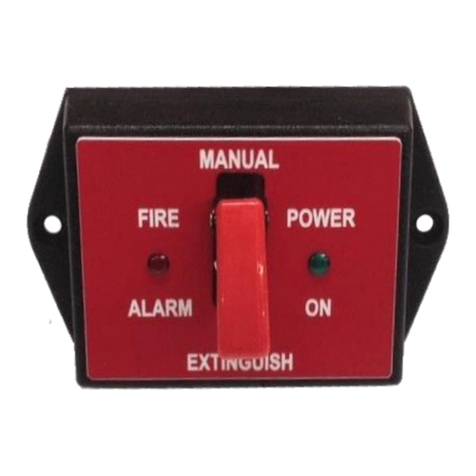
Fire Pro
Fire Pro 08100 User manual

Fire Pro
Fire Pro 08451 User manual

Fire Pro
Fire Pro FP-22408 User manual
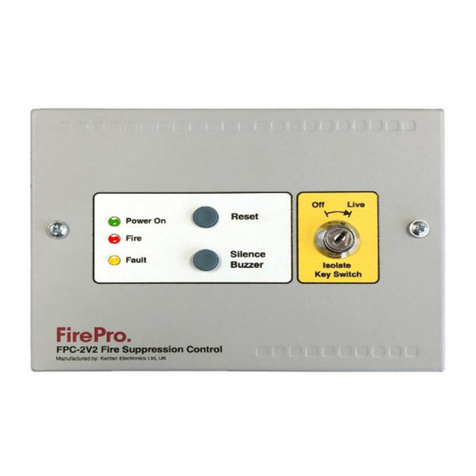
Fire Pro
Fire Pro FPC-2 User manual
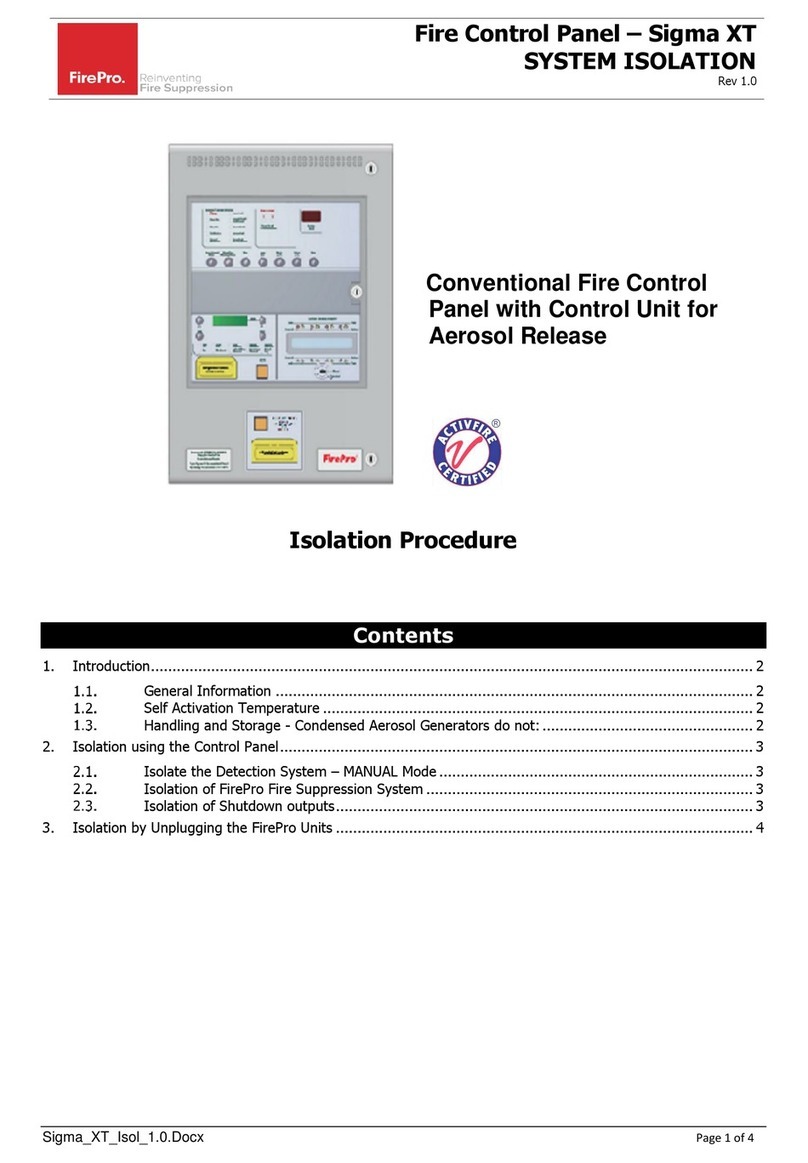
Fire Pro
Fire Pro Sigma XT Reference guide
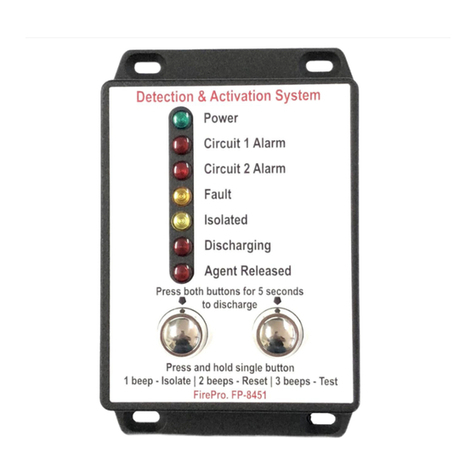
Fire Pro
Fire Pro 08451 User manual

Fire Pro
Fire Pro FPC-2 User manual
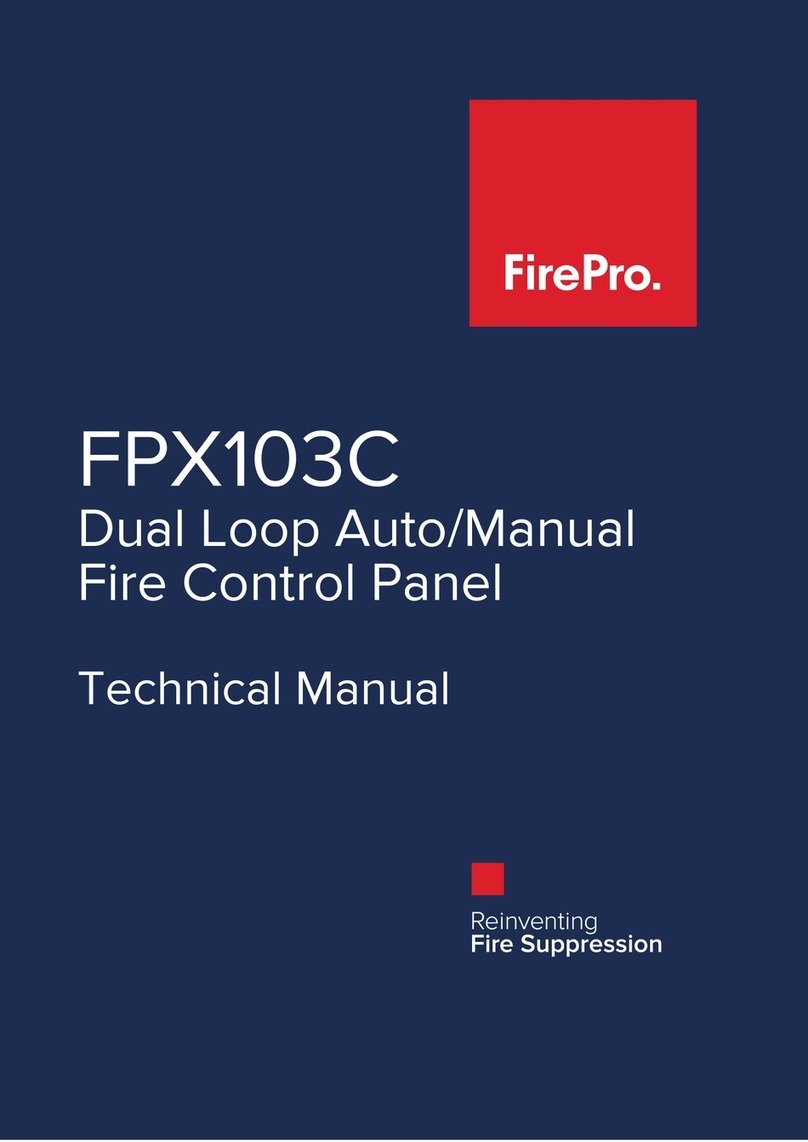
Fire Pro
Fire Pro FPX103C User manual
Popular Control Panel manuals by other brands
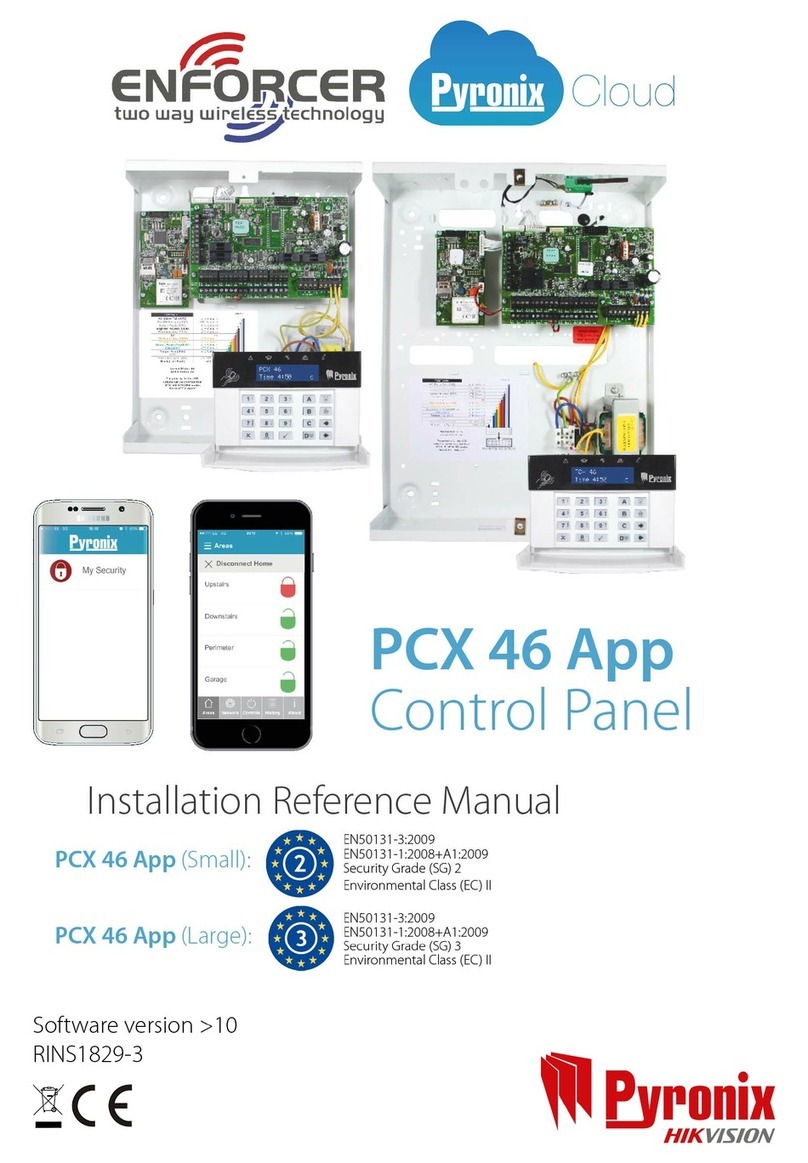
Pyronix
Pyronix PCX 46 APP Installation & reference manual
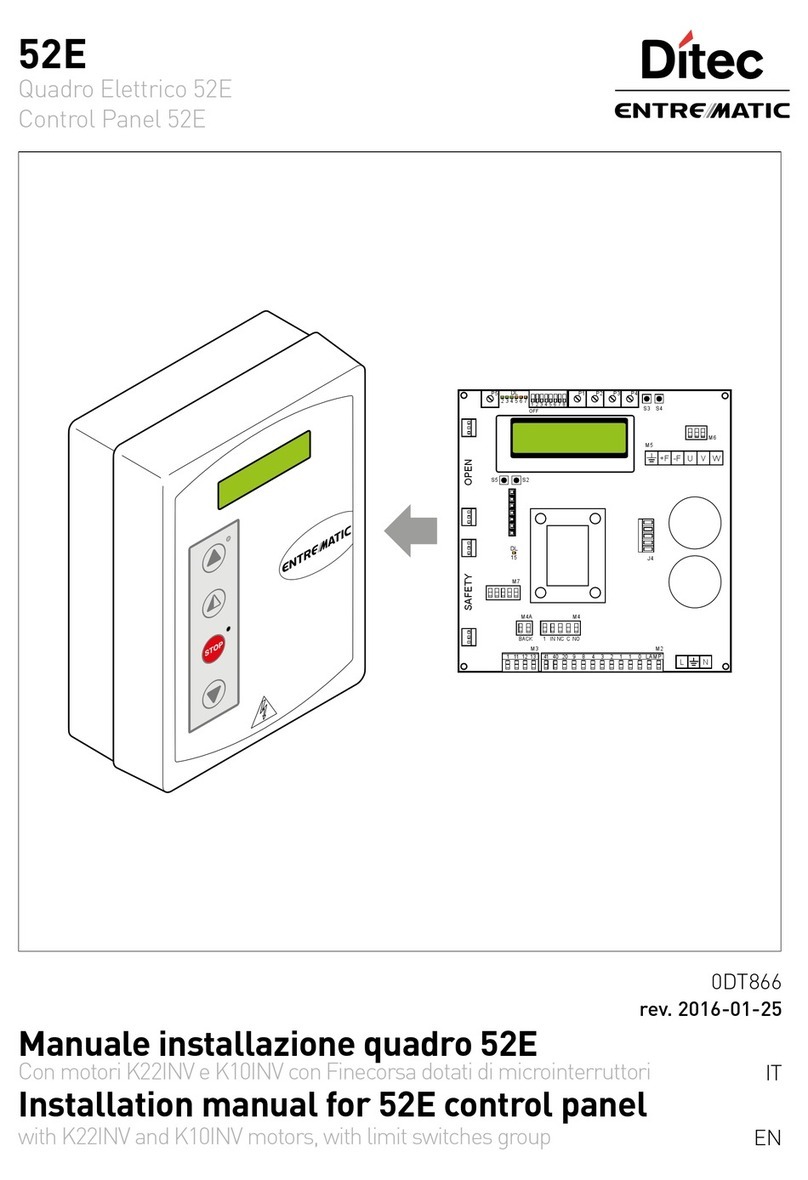
DITEC
DITEC 52E installation manual
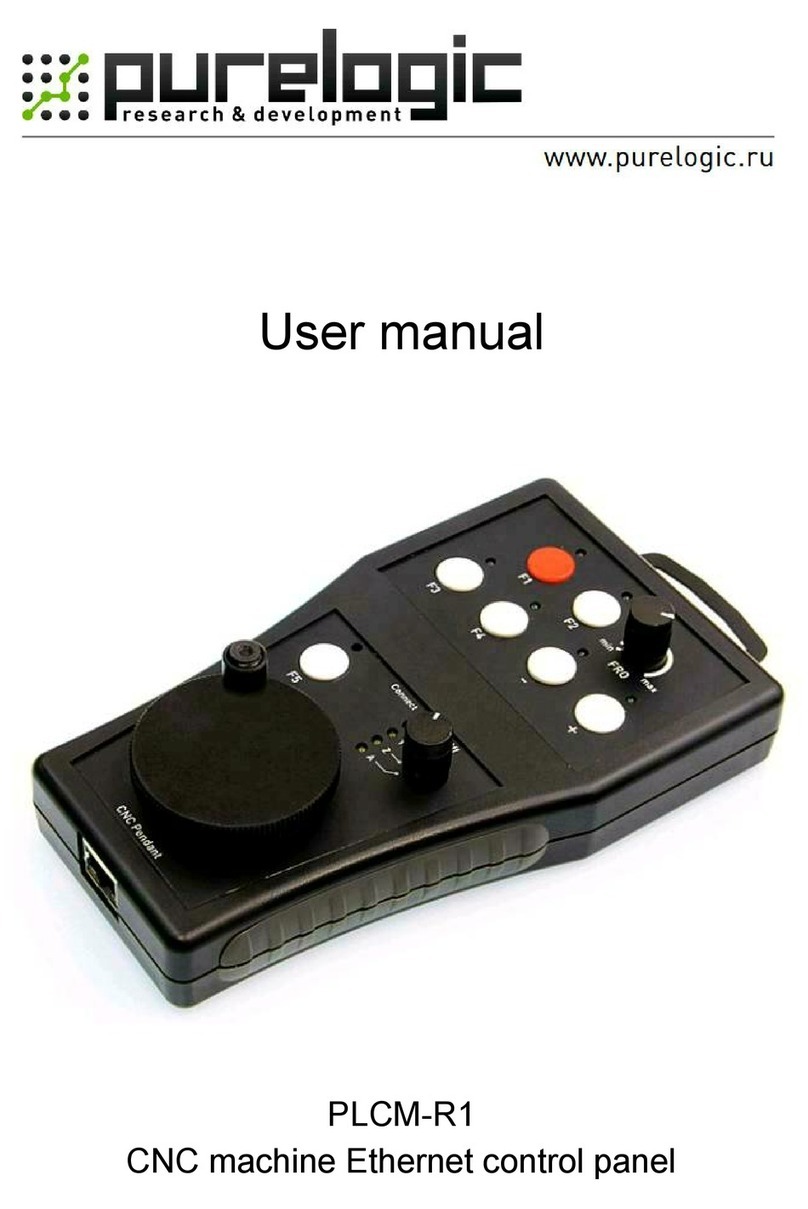
Purelogic
Purelogic PLCM-R1 user manual

DoorHan
DoorHan PCB-SW Programming instructions

SALUPO
SALUPO SOFT START PLUS 1 Instruction and installation manual
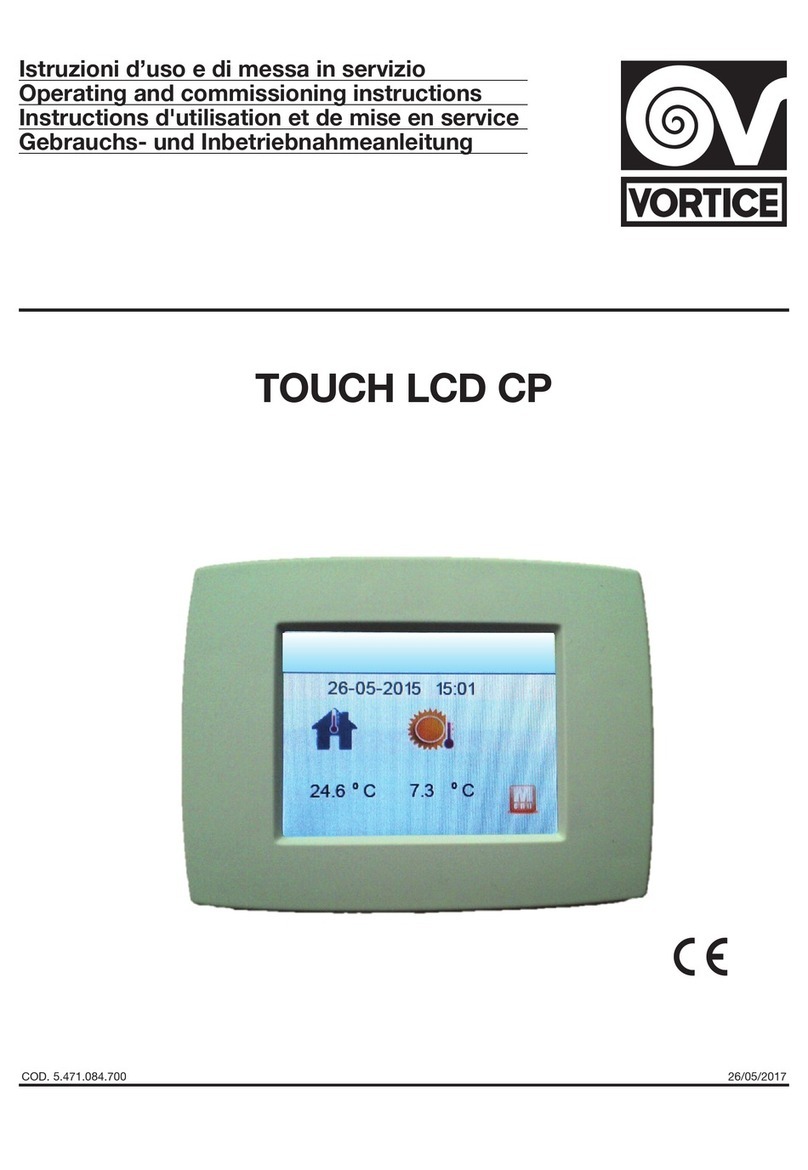
Vortice
Vortice TOUCH LCD CP Operating and Commissioning Instructions
